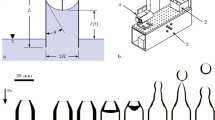Abstract
WHEN a glass tube, 6.5 mm. in external diameter, 5 mm. in internal diameter and of any convenient length, one end of which has been drawn out into the form of a cone 55 mm. long with a hair-like apex 0.1 mm. in diameter and a correspondingly small aperture (Fig. 1 (1)) is filled with water containing, say, 1 per cent. of caustic soda, and held with its point downwards at an angle of 35° above the horizontal, a minute stream of water issues from its aperture, turns round underneath its lip and ascends to a distance of 33 mm. on its outer side in the form of a series of minute, disconnected, elongated globules which appear to encircle it. In flowing upwards these globules gradually lose their identity, and finally coalesce with each other to form a substantial drop at a point where the diameter of the cone is about 2 mm.
Similar content being viewed by others
Author information
Authors and Affiliations
Rights and permissions
About this article
Cite this article
GALLOWAY, W. External Capillary Action. Nature 118, 300–301 (1926). https://doi.org/10.1038/118300b0
Issue Date:
DOI: https://doi.org/10.1038/118300b0
- Springer Nature Limited




